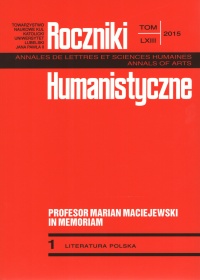Zbigniew Herbert and “Piousness” Towards Things
Abstract
The poem Elegy for the Departure of the Pen the Ink the Lamp has received not only numerous glosses and various small commentaries, but also three long articles.
However, a more narrow perspective of looking at the Elegy as an element of the evolution of Herbert's ways of approaching things, absent from reviews of the poem as yet, seems also tempting.
The attitude of the protagonist of the poem towards things is defined in the poem not so much through claims of ontology or epistemology, as rather through social customs, the practices of memory and psychological needs. Similar ways of communing with things appear even earlier in Herbert's works, however, it seems that gradually they become more and more conspicuous and in the poet's works written at a senile age they already have a dominating position. The basic frame of reference that makes it possible to understand the relations of the subject and the object that appear there, is no longer philosophy, but anthropology. Interesting tools for observation are especially supplied by the so called anthropology of things.
Although it would be difficult to place the poem in the Dasein ontology, it is worth stressing that Heidegger's care gains its own original expression in Herbert's work. It is exactly owing to this that Herbert's poem is not only about the departure of things, but also about their constant, sudden returns, about their absent presence that arouses our “piousness” towards them.
References
Augustyniak P., „Wersety panteisty”. Ontologiczne przesłanie Zbigniewa Herberta, [w:] „Pojęcia kiełkujące z rzeczy”. Filozoficzne inspiracje w twórczości Zbigniewa Herberta, red. J.M. Ruszar, Kraków 2010, s. 75-100.
Herbert Z. Elegia na odejście pióra atramentu lampy, [w:] tenże, Wiersze zebrane, oprac. R. Krynicki, Kraków 2008, s. 576-581.
Krajewski M., Przedmiot, który uczłowiecza, „Kultura Współczesna” 2008, nr 3, s. 43-54.
Ligęza W., Przedmiot i współczucie. (O „Elegii na odejście pióra atramentu lampy” Zbigniewa Herberta), [w:] Poezja w szkole średniej, red. E. Kram-Mikoś, Warszawa−Kraków 1995, s. 95-109.
Łukasiewicz J., Elegia na odejście pióra atramentu lampy, [w:] tenże, Poezja Zbigniewa Herberta, Warszawa 1995, s. 93-109.
Opacka-Walasek D., „Kołatka”, [w:] taż, Czytając Herberta, Katowice 2001, s. 107-111.
Pawelec D., Elegia, [w:] tenże, Od kołysanki do trenów. Z hermeneutyki form literackich, Katowice 2006, s. 167-191.
Pawliszcze J., Onto-lithologia Herberta, [w:] Wokół słowa. Filozofia, poezja, publicystyka, malarstwo, Kołobrzeg 2006, s. 49-60.
Rymkiewicz J.M., Krzesło, „Twórczość” 1970, nr 1, s. 50-88.
Sioma R., Krzesło i zmięta serweta: próba interpretacji „Studium przedmiotu” Zbigniewa Herberta. „Acta Universitatis Nicolai Copernici. Filologia Polska” 2001, z. 350, s. 87-102;
Utracka D., „Pamięć rzeczy”. Mityzacja i demityzacja świata rzeczy w poezji Zbigniewa Herberta, „Prace Naukowe. Filologia Polska” 1998, z. 7, s. 231.
Warzeszek S., Martina Heideggera filozofia i etyka techniki, „Warszawskie Studia Teologiczne” 2002, nr 15, s. 229-250.
Wojtkowska K., „Stołek”. Z powrotem do rzeczy. Ukryta debata z Ingardenem we wczesnej poezji Herberta, [w:] „Pojęcia kiełkujące z rzeczy”..., s. 53-73.
Copyright (c) 2015 Roczniki Humanistyczne

This work is licensed under a Creative Commons Attribution-NonCommercial-NoDerivatives 4.0 International License.





